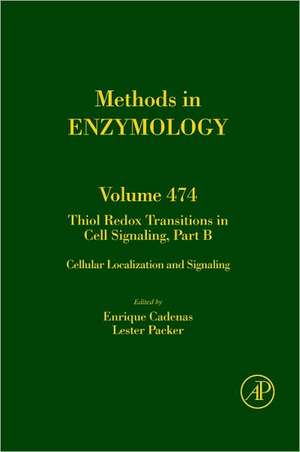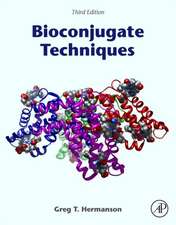Thiol Redox Transitions in Cell Signaling, Part B: Methods in Enzymology, cartea 474
Enrique Cadenas, Lester Packeren Limba Engleză Hardback – 18 aug 2010
- Along with companion volume, provides a full overview of techniques necessary to the study of thiol redox in relation to cell signaling
- Gathers tried and tested techniques from global labs, offering both new and tried-and-true methods
- Relevant background and reference information given for procedures can be used as a guide to developing protocols in a number of disciplines
Din seria Methods in Enzymology
-
 Preț: 390.54 lei
Preț: 390.54 lei -
 Preț: 391.30 lei
Preț: 391.30 lei -
 Preț: 392.01 lei
Preț: 392.01 lei -
 Preț: 391.01 lei
Preț: 391.01 lei - 28%
 Preț: 801.23 lei
Preț: 801.23 lei - 32%
 Preț: 802.54 lei
Preț: 802.54 lei - 23%
 Preț: 461.36 lei
Preț: 461.36 lei - 23%
 Preț: 460.60 lei
Preț: 460.60 lei - 23%
 Preț: 439.86 lei
Preț: 439.86 lei - 23%
 Preț: 448.15 lei
Preț: 448.15 lei - 23%
 Preț: 451.42 lei
Preț: 451.42 lei - 23%
 Preț: 445.18 lei
Preț: 445.18 lei - 5%
 Preț: 557.15 lei
Preț: 557.15 lei - 23%
 Preț: 450.67 lei
Preț: 450.67 lei - 23%
 Preț: 446.23 lei
Preț: 446.23 lei - 23%
 Preț: 435.87 lei
Preț: 435.87 lei - 23%
 Preț: 445.94 lei
Preț: 445.94 lei - 23%
 Preț: 459.55 lei
Preț: 459.55 lei - 23%
 Preț: 460.02 lei
Preț: 460.02 lei - 23%
 Preț: 450.54 lei
Preț: 450.54 lei - 23%
 Preț: 453.47 lei
Preț: 453.47 lei - 5%
 Preț: 565.37 lei
Preț: 565.37 lei - 23%
 Preț: 450.67 lei
Preț: 450.67 lei - 23%
 Preț: 464.33 lei
Preț: 464.33 lei - 23%
 Preț: 441.49 lei
Preț: 441.49 lei - 23%
 Preț: 447.44 lei
Preț: 447.44 lei - 23%
 Preț: 459.13 lei
Preț: 459.13 lei - 23%
 Preț: 450.38 lei
Preț: 450.38 lei - 23%
 Preț: 445.80 lei
Preț: 445.80 lei - 23%
 Preț: 445.35 lei
Preț: 445.35 lei - 23%
 Preț: 442.53 lei
Preț: 442.53 lei - 23%
 Preț: 450.38 lei
Preț: 450.38 lei - 23%
 Preț: 448.60 lei
Preț: 448.60 lei - 23%
 Preț: 447.57 lei
Preț: 447.57 lei - 23%
 Preț: 440.90 lei
Preț: 440.90 lei - 23%
 Preț: 448.15 lei
Preț: 448.15 lei - 23%
 Preț: 466.84 lei
Preț: 466.84 lei - 23%
 Preț: 451.42 lei
Preț: 451.42 lei - 23%
 Preț: 453.64 lei
Preț: 453.64 lei - 23%
 Preț: 459.13 lei
Preț: 459.13 lei - 23%
 Preț: 457.49 lei
Preț: 457.49 lei - 23%
 Preț: 447.44 lei
Preț: 447.44 lei - 5%
 Preț: 561.34 lei
Preț: 561.34 lei - 23%
 Preț: 447.57 lei
Preț: 447.57 lei - 23%
 Preț: 453.35 lei
Preț: 453.35 lei - 23%
 Preț: 441.95 lei
Preț: 441.95 lei - 23%
 Preț: 450.38 lei
Preț: 450.38 lei - 23%
 Preț: 449.19 lei
Preț: 449.19 lei - 23%
 Preț: 456.02 lei
Preț: 456.02 lei
Preț: 1158.17 lei
Preț vechi: 1586.54 lei
-27% Nou
Puncte Express: 1737
Preț estimativ în valută:
221.61€ • 241.48$ • 186.74£
221.61€ • 241.48$ • 186.74£
Carte tipărită la comandă
Livrare economică 23 aprilie-07 mai
Preluare comenzi: 021 569.72.76
Specificații
ISBN-13: 9780123810038
ISBN-10: 0123810035
Pagini: 392
Dimensiuni: 152 x 229 x 23 mm
Greutate: 0.75 kg
Editura: ELSEVIER SCIENCE
Seria Methods in Enzymology
ISBN-10: 0123810035
Pagini: 392
Dimensiuni: 152 x 229 x 23 mm
Greutate: 0.75 kg
Editura: ELSEVIER SCIENCE
Seria Methods in Enzymology
Public țintă
Researchers and students in biochemistry, cardiology, cell and molecular biology, neuroscience, pharmacology, endocrinology.Cuprins
- His-tag switch method for the analysis of S-nitrosylated proteins
- Identification of Protein Thiols in Mitochondrial Oxidative Phosphorylation Complexes
- Mitochondrial thioredoxin reductase: purification, inhibitor studies, and role in cell signaling
- assessing cell surface thiol status
- Induction of Thioredoxin for Mediating Preconditioning-induced Cellular Responses
- A trans sarcoplasmic reticulum membrane redox sensor in the striated muscle: exploring redox sensitivity of the ryanodine receptor calcium release channel
- Rapid approach for the detection, quantification and discovery of novel sulphenic acid or S-nitrosothiol modified proteins using a biotin-switch method
- Direct identification by mass spectrometry of in vivo S-nitrosylated peptides
- Changing paradigms in theology: From antioxidant defence to redox regulation
- Determination of GSNO formation in biological samples by HPLC electrochemical detection
- Alteration of thioredoxin reductase 1 levels in elucidating cancer etiology
- thiol-labeling technology in proteomics
- Analytical methods for the determination of sulfur metabolite concentrations in cell extracts
- Chemical tagging and mass spectrometry-based identification of protein thiols modified by lipid peroxidation-derived a,b-unsaturated aldehydes
- Measuring protein thiol redox changes in mitochondria
- Engineering of redox domains for monitoring electron transfers spectroscopically
- Approaches to detection of cysteine sulfenic acids in proteins using dimedone-based chemical probes
- Evaluation of conditions affecting degree of sulfenic acid labeling in redox-sensitive proteins
- Colorimetric and spectrophotometric assays of sulfiredoxin
- Quantifying disulfides in specific proteins
- A simple method of detecting oxidatively-modified proteins
- Role of Glutathione Conjugates in Cell Signaling
- Regulation of Protein Function by Sulfinic Acid Formation
- Mass spectrometry approaches for the study of the oxidation state of protein cysteine residues
- assays of protein tyrosine phosphatase oxidation
- oxidation state of cellular 2-Cys peroxiredoxins (reduced thiol, disulfide and hyperoxidised) by non-reducing SDS-PAGE and immunoblotting



















